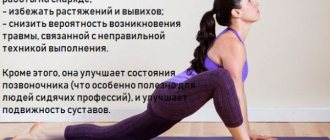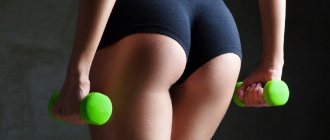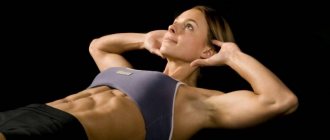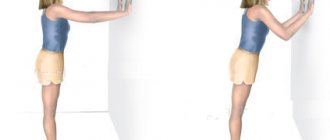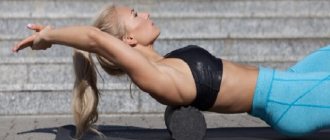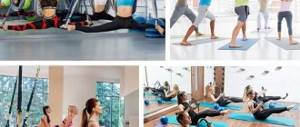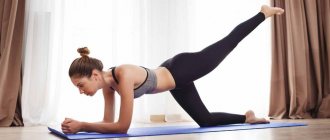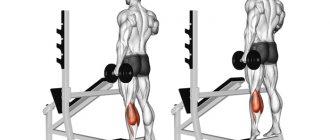Indications for the use of therapeutic exercises
Exercise therapy for the back and spine requires a preliminary accurate diagnosis and selection of the most effective exercises. It is allowed to start performing the complex only after consulting a specialist and passing all diagnostic procedures.
Therapeutic exercises are relevant for patients with diseases such as:
- curvature of the spine (scoliosis);
- osteochondrosis;
- the presence of a hernia between the vertebrae;
- disc protrusion;
- paralysis;
- paresis;
- instability of the spinal column.
- as rehabilitation after surgery or injury.
The main goal of exercise therapy is to relax muscles and ligaments, as well as strengthen them. This will help the spine cope with more load without pain or discomfort.
Physical therapy course in Moscow and the Moscow region
The Central Clinical Hospital of the Russian Academy of Sciences offers high-precision diagnostics of various pathologies and exercise therapy classes using modern techniques and simulators. Our doctors develop effective courses of exercises to treat diseases or carry out rehabilitation measures.
The Central Clinical Hospital of the Russian Academy of Sciences uses the latest simulators for physical therapy exercises
:
- the HUBER system is a patented advanced development by LPG Systems, used to increase physical endurance, increase and restore muscle volume and improve coordination of movements, correct posture, treat pathologies of the joints and spine and rehabilitation after completion of the main treatment course;
- “Motomed” is a device that shows high efficiency in the postoperative period, used for the restoration of tissues of the lower extremities and lumbar region, as well as the prevention of complications caused by prolonged immobility;
- Geragem is a mechanotherapeutic device that provides a relaxing and analgesic effect through acupressure (pressure on active points), roller massage and thermotherapy;
- “Stabilan” is a diagnostic complex based on computer stabilography for diagnosing balance disorders and rehabilitation for motor-coordination disorders.
Patients are offered individual and group classes with instructors and doctors in a comfortable room.
You can sign up for a consultation at the Central Clinical Hospital of the Russian Academy of Sciences by phone or through the website.
Contraindications
Like any other physical activity, physical therapy is dangerous in a number of cases. The fact is that when performing exercises, the load on the entire body increases. In particular, on the cardiovascular, respiratory, musculoskeletal systems. This may cause some diseases to worsen.
So, among the contraindications there are:
- recent surgery;
- diseases of the heart and blood vessels, a history of recent stroke or heart attack;
- muscle or ligament ruptures due to injury;
- oncological diseases;
- chronic kidney or liver disease;
- bleeding of any etiology;
- fractures, dislocations.
The use of exercise therapy for scoliosis
Scoliosis is a common diagnosis among patients of any age. It manifests itself in the form of curvature of the spine due to incorrect posture or long and regular stay in the wrong position.
It is impossible to completely align the spinal column, but you can effectively prevent possible deterioration. The most important thing is to choose the right set of exercises that will be aimed at relaxing the muscles and ligaments. The algorithm of action for scoliosis depends on the stage of the disease and the location of the curvature.
Exercise therapy for the back and spine is most effective in the presence of stage 1 or 2 of the disease. At subsequent stages of curvature development, gymnastics alone will not be enough. Here you need to solve the problem comprehensively, using drug treatment, physiotherapy and strict medical supervision when performing exercises.
The complex for scoliosis consists of several stages:
- warm-up;
- base;
- hitch.
Warm-up exercises
In order for gymnastics to be not only effective, but also safe, it is important to start the lesson with a warm-up. By doing simple exercises, a person helps his muscles and ligaments warm up, thereby preparing for physical activity.
Exercises for warming up exercise therapy for scoliosis:
- You need to rest your straight back against the wall and your feet on the floor. The neck, shoulder blades, back of the head and buttocks should touch the surface of the wall. In this position, move away from the wall and freeze for a few seconds. It is important to ensure that your breathing remains even. This exercise helps to fix the spine in a straight position.
- Place your feet shoulder-width apart and begin to slowly squat, stretching your arms in front of your body to a horizontal position, parallel to the floor surface. When lowering down, you need to inhale slowly, when going up, exhale smoothly.
- Relax the muscles of the back and neck, perform circular movements with your shoulders.
- Stand up straight, raise your arms up, stretching your body and back behind them. The top of the head also tends upward. Hold this for a couple of seconds, then smoothly lower down, exhaling air and placing your arms along your body.
Do not forget about this part of the lesson; it must be performed every time before the basic exercises.
Basic exercises
After warming up, you should begin the main part of the exercises:
| № | Name | Description of the exercise | Number of repetitions |
| 1 | Scissors | Lying on your back, raise your legs and pelvis, fix your body with your hands. Make swings with your legs that resemble the work of scissors. If it’s difficult to raise your body so high, you can perform a lighter version without lifting your lower back from the floor. To do this, lying on your back, you should raise both legs to a height of about 20 cm from the floor, and then perform swings. | One approach consists of 20 swings. The number of approaches can be from 1 to 4, depending on the physical shape of the person and his state of health. |
| 2 | Wiggles | Standing on all fours, try to sit on your buttocks, while not lifting your palms off the floor. Using them, move the body in a horizontal plane, smoothly moving first to the right, then to the left. | 5-10 times in one approach. Number of approaches 1-5. |
| 3 | Kitty | This exercise, familiar to many, improves the mobility of the vertebrae, relieving pressure from the thoracic and lumbar spine. Get on all fours, begin to smoothly bend your back in the lower back and chest, take a breath. Now smoothly round the spine in these places, exhaling air. As a rule, after just a few approaches you feel relief in your back. | 10-15 deflections in one approach. Number of approaches 2-4. |
| 4 | Hyperextension | One of the most effective exercises, however, a special simulator is required to perform it. The exercise is aimed at working the extensor muscles of the back and strengthening the buttocks. You should lie down in the exercise machine and fix your legs. With a straight back, you need to put your hands behind your head, smoothly lower down and up. When performing the complex at home, you can lie with your pelvis on a pillow or a large towel rolled into a roll. | 10-15 repetitions per approach. Number of approaches 2-4. |
| 5 | Raising Limbs | Take a knee-elbow position, raise your right arm and left leg at the same time, trying to keep them parallel to the floor. Freeze for a few seconds, then repeat the same with your left arm and right leg. The exercise helps to stretch the muscles of the back, shoulders and hips. | Number of repetitions 20, recommended number of approaches 4 |
| 6 | Pelvic twist | Lie with your back on the floor, put your arms to your sides, palms down, bend your knees, and press your feet to the floor. Lower your knees to the left and turn your head to the right. Then vice versa - knees to the right, and head to the left. | 10 times in one approach. Number of approaches up to 4. |
Final part
The cool-down should be done smoothly, allowing the body to rest and the muscles to relax.
This part of the lesson should not be neglected, since by completing the complex the spine will recover faster for the following activities:
- Sit on the floor, clasp your knees with your hands. Start rolling on your back from head to tailbone and back. It is important to avoid sudden movements. The spine is massaged, blood supply and nutrition to the musculoskeletal structures are improved. Repeat the exercise 5-7 times.
- Place your hands behind your back, stand on your heels, and walk like them for a minute. Your back should remain straight the entire time.
- Raise your arms up, stand on your toes. Walk in this position for 1 minute. It is important to monitor the position of your back; it should be straight.
- Walk in place, raising your hips high. The exercise is performed for 1 minute.
- After the work done, raise your arms up, inhale deeply, and as you exhale, slowly lower your arms. Repeat 3-5 times.
After the work has been done, you can lie down for a while on a flat surface, completely relax and feel relief in your back.
Basic principles of gymnastics: benefits for the body
Therapeutic exercise for the spine is a specific set of physical exercises, necessary for almost everyone, aimed at the prevention and treatment of back diseases.
Without realizing it, we cause irreparable harm to our spine every day: we don’t take care of our posture, we don’t play sports, we don’t follow a sleep schedule, we don’t eat right. This is where all the problems arise. To partially or even completely get rid of them, you need an integrated approach, lifestyle changes and, of course, sports.
Basic principles to follow before starting classes:
- Choosing a training location. Nothing should bother you. Before you begin, ventilate the room in which you will be practicing. The temperature should be comfortable;
- Choose a comfortable suit that does not restrict movement (preferably a sports suit). Clothes must be selected strictly according to size;
- You can purchase a yoga mat, this will allow you to comfortably perform exercises in a lying position, and the rubberized surface will not allow you to slip;
- We always start with a warm-up. Let it be a march, circular movements of the head, pelvis, arms and legs. This will warm up the body, preparing it for a more serious load. Duration - 5-10 minutes;
- We do it measuredly, without rushing. Avoid sudden jerks;
- If for some reason you cannot perform this or that exercise, then skip it: you should not do it through force;
- There should not be too much pain during gymnastics! If this happens, it is better to stop training and consult a doctor to find out the reasons;
- Watch your posture. The back is straight, the shoulder blades are slightly brought together - this is an important condition for the correct execution of the exercises;
- Don't forget to breathe, don't hold your breath under any circumstances! Can be combined with breathing exercises;
- Make it a rule to start your day with physical exercise. Only regular exercise will give positive results! The break between workouts should not exceed 1-2 days;
- Exercise on an empty stomach or 2-3 hours after eating.
The benefits of exercise therapy are undeniable, since the results are visible even after the first lesson:
- normalization of blood circulation;
- cessation of pain;
- improved posture;
- restoration of tone and elasticity to muscles and joints;
- reduction of excess body weight;
- strengthening the muscle corset;
- general improvement of the body;
- improved mood: vigor appears, fatigue disappears.
Physical therapy can be done not only at home, but also at work, if it is sedentary and you are at the computer all day. Give yourself short breaks, walk around the office, do simple exercises (stretching, bending, etc.), this will relieve tension from the spine and energize you for the rest of the day.
Exercises for the treatment of spinal osteochondrosis
Osteochondrosis is a disease in which pathological changes occur in the cartilage in the area of the intervertebral discs, which disrupts the nutrition of the surrounding tissues. The disease can occur in any part of the spine and always manifests itself in the form of pain and impaired mobility.
Exercise therapy and its regular implementation helps to alleviate the patient’s condition and eliminate tension in the back and spine as a whole. It is important to choose the right exercises; they are different for each department.
Therapeutic gymnastics for osteochondrosis is a set of gentle exercises that do not cause muscle fatigue. Actions are aimed at strengthening the muscle corset and preventing further development of the disease. You should exercise only after the acute period of the disease is over and the attending physician has given permission to begin physical exercise.
It is important to ensure that there is no discomfort or pain while performing the complex.
Neck
Cervical osteochondrosis is a common disease that, if not treated promptly, can lead to complications. The exercises are aimed at improving blood supply to the cervical vertebrae.
It is important to monitor the position of your back during exercises; it should always remain level:
- Stand up straight or sit with a straight back on a chair. Smoothly turn your head to the left, then to the right. Repeat the exercise 10 times.
- Sitting on a chair, lower your head as low as possible, try to press your chin to your chest. You may feel a slight stretch in the back muscles of the neck. Then slowly raise your head. Repeat 10 times.
- While remaining on the chair, try to tuck your chin in, moving your neck back. Slowly return to the starting position. Repeat 10 times.
- Sitting at the table, place one elbow on the table surface and rest your palm on your temple. Tilt your head towards your palm, providing slight resistance. At this stage, you can feel the work of the lateral muscles of the neck. Repeat 10 times, then change hands.
- Place your palm on your forehead and tilt your head towards your palm, offering resistance with your hand. Repeat 10 times, rest for a few seconds and change hands.
- Raise your shoulders as high as possible, hold for 10 seconds, return to the starting position. Repeat 5-10 times.
- Massage the back of your head with your fingertips. Movements should be intense and deep, but not painful.
Thoracic region
Exercise therapy for the back and spine for osteochondrosis of the thoracic region is aimed at strengthening the muscle frame and normalizing the breathing process. Regular practice relieves pressure from the back, nerve fibers and blood vessels. Displacement of the vertebrae leads to the development of edema in the surrounding tissues, but exercises can eliminate this symptom.
Osteochondrosis of the thoracic region is also dangerous because it can affect the functioning of the cardiovascular system. Often, curvature of the spine in the chest leads to arrhythmia or tachycardia, pain in the heart area. Exercise therapy can eliminate these symptoms.
The complex consists of exercises such as:
- Sitting on a chair, clasp your hands behind your head and bring your elbows together in front. Smoothly turn the body first to the right, then to the left. It is important to monitor your breathing and avoid pain.
- Alternately slowly raise and then lower your shoulders. Repeat 20 times on each side.
- To perform the following exercise, you will need dumbbells or small plastic bottles of water. You should lie on your stomach, pick up dumbbells, spread your arms to the sides, connecting your shoulder blades.
- Sitting on a chair, press your back as much as possible against its back. After which you need to bend back as much as possible, and then lean forward. If possible, it is recommended to bend to the right and left, clasping your hands behind your head.
- Stand up straight, place your feet shoulder-width apart. Slowly bend towards your left and right legs, then carefully straighten up. Repeat the exercise 5-7 times.
- For this exercise you will need a scarf or cloth. You need to sit on a chair or stand on a hard surface. Wrap the fabric around the chest so that the ends are tied in front. Take a deep breath and then exhale. As you exhale, you need to tighten the fabric more tightly, helping to expel the entire volume of air from the lungs. Repeat 5-7 times. When performing the task, you should be careful not to feel dizzy.
- Sitting on your heels, lean forward and touch your forehead to the floor. Extend your arms forward, touching your ears. When stretching your arms, take a deep breath, and as you exhale, return your arms back.
- Perform the “cat” exercise, alternately bending and arching your back in the lower back and chest.
Small of the back
Symptoms of osteochondrosis in the lower back are aching pain, especially when staying in an uncomfortable position for a long time or after running and training.
It is best to do complexes for the cervical and thoracic regions after warming up, and then add the following:
- The exercise is very similar to the “cat”, but the head and tailbone should not be lowered and raised at the same time, but in turn, always starting from the tailbone. Get on your knees, place your hands firmly on the floor. Raise the tailbone, then the sacrum, lower back, thoracic region, and finally the neck and head, rounding the back. After this, bend the tailbone, then the sacrum and then in the same order, arching the back. Breathe smoothly and slowly. Repeat at least 10 times.
- Lying on your back, bend your knees, clasp your hands behind your head. Lower your knees to the right, leaving your torso and shoulder blades pressed to the floor. Do 10 times in 1 direction.
- Lying on your back, pull your toes towards you. Stay in this position for a few seconds and relax.
Gymnastics by Paul Bragg
Paul Bragg is a representative of alternative medicine, a naturopath. He noted that a healthy, straight spine is a conductor of energy, which ensures good health, mood, and energy. He developed a system of exercises, thanks to which improvements are felt after 2-3 days of daily exercise.
Gymnastics by Paul Bragg
The first 7 days of training take place at a slow pace. Each exercise is performed 1-4 times, gradually increasing repetitions to 10-15. The amplitude of movements is increased gradually. Deterioration in well-being, pain, discomfort are indications to reduce the intensity of training. Comprehensive implementation of the exercises below leads to better therapeutic and health results.
Traction
Spinal traction exercises have a beneficial effect on the nervous system, the functioning of the visual organs, and the condition of the nerve endings. Works well on the muscle tissue of the cervical region.
It is recommended to perform the following exercises to stretch the spinal column:
- Lie on the floor on your stomach, spread your feet shoulder-width apart. Raise your pelvis and arch your back, like cats arch. Use your fingers and toes for support.
- Lower yourself onto your pelvis and raise your head. Lower your pelvic area down, hold for a few breaths and slowly lower down. Repeat several times.
Such exercises relax the spine, reduce stiffness, tension, and improve motor activity.
Twist
The spinal twist exercise helps to strengthen and restore the functional state of the thoracic spine. Beneficial for nerve endings, urinary system organs, and liver.
Lie on the floor, on your stomach, arch your back and raise your pelvis, resting on your fingers and toes. Turn your pelvis to the left side, lowering your side as low as possible to the floor. Repeat for the opposite side. All movements are slow and smooth, avoiding pain.
Stretching
Spinal stretching exercises restore metabolic processes and balance in the body. Effective for dizziness and headaches:
- Lie on your back, bend your legs and clasp your knees with your hands. Start swinging left and right.
- Raise your head and try to touch your chin to your knees. Hold this position for 10 seconds.
Repeat the exercise 2-3 times.
Bridge
The “Bridge” exercise is effective for training the lower back, relaxing the spine and having a beneficial effect on the intervertebral discs.
Sit on the floor, focusing on your hands, bend your legs. Raise your pelvis, resting your palms on the floor, straighten your legs. Take 2-4 breaths, exhale, and then relax your arms and legs. The exercise is done at a slow, rhythmic pace.
Let's walk on all fours
This is an important, basic exercise that stretches, trains and strengthens the gluteal muscles:
- Lie down on the floor. on the stomach. Raise your pelvis, arch your back.
- Lower your head as close to your chest as possible.
- Lean on straight arms and legs and walk for 2-3 minutes.
- Rest and repeat this exercise again.
It is recommended to train every day. If you feel better, you can exercise every other day.
Exercises for herniated thoracic spine
If there is a hernia, self-medication is strictly prohibited. Any actions should be carried out only after consulting a doctor and determining the exact location of the pathology.
Thoracic hernias are quite rare, but they can cause severe discomfort to a person.
The following exercises will help you cope with pain:
- Sit on a chair, clasp your hands at the back of your head. Slowly bend back until your back fits snugly against the back of the chair. You need to remain in this position for a few seconds, and then bend forward smoothly. Repeat no more than 4 times.
- Lie on the floor and place a cushion under your upper back. This could be a rolled up towel. As you inhale, make a bend, bring your upper limbs to the back of your head, while exhaling, try to lift your upper body off the surface of the floor, then relax and slowly lower back. Repeat the movement 3-4 times.
- Lying on the floor, spread your legs wide apart. The pelvis, feet and buttocks should be immobilized and pressed tightly to the surface. Your arms should be crossed over your chest. In this position, turn your body to the right, slightly lifting it. Smoothly go back and do the same movement to the left. Repeat on each side 10 times.
- Lie on your side, with your lower arm extended upward so that it is parallel to your torso. Gently raise your upper hand up and behind your head. Both arms should be parallel to the floor. Stay in this position for a few seconds. Repeat the exercise on the other side of the body. The number of executions is from 5 to 7 for each hand.
Methodological recommendations for motor mode in the acute period
In the acute period, in the presence of acute pain, strict bed rest should be observed. Exercise therapy is used mainly for hygienic purposes and is of a general strengthening nature. When moving the lower extremities, do not allow the lumbar lordosis to increase, which can increase pain. In this regard, when performing physical exercises, you should place a soft cushion under your shins.
At the second stage of the acute period, with a slight decrease in pain intensity, isometric exercises should be carefully included to train the abdominal muscles and gluteus maximus muscles.
Exercises that cause pain should be limited in amplitude, degree of muscle tension, or eliminated altogether. Do not exercise through pain!
The number of repetitions of each exercise is 8-10 times. The pace of the exercises is slow.
Exercises for lumbar hernia of the spine
Lumbar hernias are the most common.
Exercise therapy for the back can be performed using a special ball
If available, the following exercises are possible:
- First you need to relax the extensor muscles of the back. To do this, you need to lay something soft in the form of a pillow on a stool, lie on your stomach on it, freely lower all four limbs and hover in this position for 3-4 minutes.
- Lying on the floor, you need to bend your knees under you. Try to tense your abdominal muscles as much as possible while inhaling; while exhaling, you should relax them as much as possible.
- Lying on the floor, with your arms extended along your body, your legs remain straight. Lift your back off the floor, leaving your buttocks and legs motionless, and freeze in this position for 8-10 seconds. After this, return the body to its original position. It is recommended to do 10 exercises in one approach, the number of approaches from 1 to 4.
- Get on all fours, then alternately raise your arms and legs, simulating walking in place. It is important to fix the pelvis and not wiggle it. The duration of the exercise is at least 30 seconds, repeat 3 to 5 times.
- Lying on your back, raise your left leg and right arm, try to connect them, slightly lifting your body, then change limbs. Do 10-15 times with each pair of limbs.
- In some cases, with a hernia, hanging on a bar is recommended, but the exercise can only be performed under the supervision of a neurologist.
Exercises with a stick
Exercise therapy for the back and spine includes exercises using a gymnastic stick:
- Stand straight, feet shoulder-width apart, extend your arm, raise it above your head, and clasp the stick wide. Turn it right and left parallel to the floor. Until the hands cross each other.
- Gently lean forward with a straight back, rest your hands on the stick. Make a few springy swings up and down.
- Standing straight, place the stick in front of you, resting one end on the floor. Throw your leg over a stick. Then change limbs. It is important to try to keep your knees straight.
- The exercise is similar to the previous one, only the stick should now be placed not in front of the person, but to the side of him. You should still try to get your straight leg over the stick.
- Standing, raise your arms up, grasping the stick wide. Lunge forward with one leg, while trying to keep the other straight; you should bend your back, moving your arms with the stick back.
- While standing, grab the stick wide and lower your hands behind your back. Bend forward 3 times, slightly springing your body. Make sure your back remains straight. It is important to bend in the lumbar region and move the stick upward.
- Stand up straight, place the stick behind your back, lowering it onto your shoulder blade. Lean forward and turn your torso to the right. Then straighten up and repeat the same to the left.
General recommendations for exercise therapy classes
Therapeutic exercise is prescribed by medical standards for the treatment of many diseases. Each clinic has specialized departments with qualified specialists.
Therefore, you should follow the basic rules:
- Before starting any exercise, you should consult a doctor and undergo a prescribed examination. This is necessary to make an accurate diagnosis.
- The first few sessions are best done under the supervision of a specialist.
- It is important to warm up and warm up your muscles beforehand. This will help avoid possible injuries.
- Monitor your condition. If discomfort or pain occurs, it is better to refuse classes.
- It is very important not to overdo it. At first glance, the exercises seem simple, so some patients are in a hurry to take on more load. However, do not forget that the back muscles may be weakened, so they require a gradual increase in load.
- Before classes, it is better not to use painkillers and muscle relaxants. This way the patient will be able to independently control the reaction of the sore back to new exercises.
- Do not forget that only long-term and regular exercise therapy will give tangible results, so it is important to be patient and not expect the pain to go away after the first session.
- After completing all the exercises, do not forget to cool down.
- In cases of hernias, complexes are performed using constant support while lying or sitting.
The spine should remain healthy throughout your life. The condition of the whole organism directly depends on this. Therefore, it is advisable to perform exercise therapy for the back not only for the purpose of treatment, but also for the purpose of prevention.
Author: Olga Orlova
General rules and recommendations
If you are planning to do back exercises at home, consider the following tips:
- Do not overdo it. Don't exhaust yourself with long and hard workouts. It is enough to do gymnastics 3-4 times a week. At the same time, training should not be to the point of exhaustion.
- Gradually increase the load. Do not lift heavy weights or immediately perform exercises without physical preparation. Gradually increase the weight and number of approaches to prevent injury and other unpleasant consequences.
- Don't make sudden movements. They can aggravate the condition, lead to severe pain and complications. All movements must be smooth. Do not do sudden twists, lunges or jumps.
- Watch your breathing. It is important that during gymnastics a sufficient amount of oxygen enters the body. You need to start the exercise while inhaling and finish while exhaling.
- Focus on quality rather than quantity. Exercises will be of no benefit if done incorrectly. Follow the instructions strictly. If you are not sure about the correctness of actions, contact a specialist (rehabilitation doctor or trainer).
- For training, choose comfortable clothes. It should not hinder movement. It is worth choosing wardrobe items made from natural fabrics, as they do not disturb natural air exchange.
- Consistency is the main principle. You can achieve the desired results from training only if you do it regularly.
Important! If during exercise you experience pain, headache, weakness, nausea or vomiting, stop exercising immediately. Be sure to consult your doctor for advice.
The therapeutic effect of exercise is achieved by improving blood supply to the spine. This leads to cell nutrition and activation of regenerative processes.
